55 DMV Questions of Vulnerable Road Users
Note:
If you wish to check whether you have master these questions, you may
click on the button above to practice with questions only from this DMV topic.
If you do not have an account yet,
Sign Up one now, it is FREE!
1. In daylight, an approaching motorcyclist is using a dipped headlight. Why?
A. So that the rider can be seen more easily
B. To stop the battery overcharging
C. To improve the rider’s vision
D. The rider is inviting you to proceed
2. Motorcyclists often look round over their right shoulder just before turning right. This is because
A. They need to listen for following traffic
B. Motorcycles do not have mirrors
C. Looking around helps them balance as they turn
D. They need to check for traffic in their blind area
3. An injured motorcyclist is lying unconscious in the road. You should
A. Remove the safety helmet
B. Seek medical assistance
C. Move the person off the road
D. Remove the leather jacket
4. You should NEVER attempt to overtake a cyclist
A. Just before you turn left
B. Just before you turn right
C. On a one-way street
D. On a dual carriageway
5. You are turning left at a junction. Pedestrians have suddenly started to cross the road. You should:
A. Go on, giving them plenty of room
B. Stop and wave at them to cross
C. Blow your horn and proceed
D. Give way to them
6. You are driving towards a pedestrian(zebra) crossing. Waiting to cross is a person in a wheelchair. You should:
A. Continue on your way
B. Wave to the person to cross
C. Wave to the person to wait
D. Be prepared to stop
7. You have a collision while your car is moving. What is the first important thing you must do?
A. Stop only if there are injured people
B. Call the emergency services
C. Stop at the scene of the accident
D. Call your insurance company
8. Motorcycles ride in day light with their headlights switched on because
A. It is legal requirement
B. There is a speed trap ahead
C. They need to be seen
D. There are speed humps ahead
9. You are driving in town. There is a bus at the bus stop on the other side of the road. Why should you be careful?
A. The bus may have broken down
B. Pedestrians may come from behind the bus
C. The bus may move off suddenly
D. The bus may remain stationary
10. You see a group of horse riders as you approach a roundabout. They are indicating right but keeping well to the left. You should:
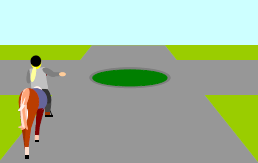 A. Proceed as normalB. Keep close of themC. Cut in front of themD. Stay well back
A. Proceed as normalB. Keep close of themC. Cut in front of themD. Stay well back
11. You are following a motorcyclist on an uneven road. You should:
A. Allow less room to ensure that you can be seen in their mirrors
B. Overtake immediately
C. Allow extra room in case they swerve to avoid pot-holes
D. Allow the same room as normal because motorcyclists are not affected by road surfaces
12. Why should you particularly look for motorcyclists and cyclists at any junction?
A. They nay want to turn into the side road
B. They may slow down to let you turn
C. They are harder to see
D. They might not see you turn
13. When you are overtaking a cyclist in the road, you should leave as much room as you would give to a car. What is the main reason for this?
A. The cyclist might change lanes
B. The cyclist might get off the bike
C. The cyclist might swerve
D. The cyclist might have to make a right turn
14. You are driving on a narrow country road. Where would you find it most difficult to see horses and riders ahead of you?
A. On left-hand bends
B. When downhill
C. When uphill
D. On right-hand bends
15. What is the most common cause of road accidents?
A. Weather conditions
B. Driver error
C. Road conditions
D. Mechanical failure
16. Which type of vehicle is most affected by strong winds?
A. Tractor
B. Motorcycle
C. Car
D. Tanker
17. If you are following a car driven by an elderly driver, you should:
A. Expect the driver to drive badly
B. Flash your lights and overtake
C. Be aware that the driver’s reactions may not be as fast as yours
D. Stay close behind and drive carefully
18. Your car hits a pedestrian at 60 kph. The pedestrian will:
A. Certainly be killed
B. Certainly survive
C. Probably be killed
D. Probably survive
19. You notice horse riders ahead of you. What should you do FIRST?
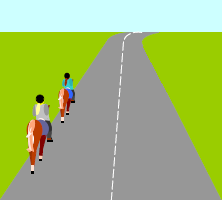 A. Pull out to the middle of the roadB. Be prepared to slow downC. Accelerate around themD. Signal right
A. Pull out to the middle of the roadB. Be prepared to slow downC. Accelerate around themD. Signal right
20. When emerging from a side road into a queue of traffic which cars can be especially difficult to see?
A. Motorcycles
B. Tractors
C. Milk floats
D. Cars
21. You are driving on a quiet country road. What should you expect to see coming towards you on YOUR side of the road?
A. Motorcycles
B. Bicycles
C. Pedestrians
D. Horse riders
22. You are driving behind three cyclists. They approach a roundabout in the lefthand lane. In which direction should you expect the cyclists to go?
A. Left
B. Right
C. Any direction
D. Straight ahead
23. You are driving behind a moped or small motorcycle. You want to turn left just ahead. You should:
A. Overtake the moped before the junction
B. Pull alongside the moped and stay level until just before the junction
C. Sound your horn as a warning and pull in front of the moped
D. Stay behind until the moped has passed the junction
24. How should you overtake horse riders?
A. Speed is not important but allow plenty of room
B. Use your horn just once to warn them
C. Drive slowly and leave plenty of room
25. Who is especially in danger of not being seen as you reverse your car?
A. Motorcyclists
B. Car drivers
C. Cyclists
D. Children
26. You are driving past parked cars. You notice a wheel of a bicycle sticking out between them. What should you do?
A. Accelerate past quickly and sound your horn
B. Slow down and wave the cyclist across
C. Brake sharply and flash your headlights
D. Slow down and be prepared to stop for a cyclist
27. As you approach a pelican crossing the lights change to green but elderly people are halfway across. You should:
A. Wave them to cross as quickly as they can
B. Rev your engine to make them hurry
C. Flash your lights in case they have not heard you
D. Wait because they will take longer to cross
28. You are about to reverse into a side road and a pedestrian wishes to cross behind you. You should:
A. Wave to the pedestrian to stop
B. Give way to the pedestrian
C. Wave to the pedestrian to cross
D. Reverse before the pedestrian starts to cross
29. If you see a pedestrian carrying a white stick, this shows that the person is:This shows that the person is:
A. Disabled
B. Deaf
C. Elderly
D. Blind
30. A horse rider is in the left-hand lane approaching a roundabout. The driver behind should expect the rider to:
A. Go in any direction
B. Turn right
C. Turn left
D. Go ahead
31. You intend to turn right into a side road. Just before turning you should check for motorcyclists who may be:
A. Overtaking on your left
B. Following you closely
C. Emerging from the side road
D. Overtaking on your right
32. You are at the front of a queue of traffic waiting to turn right into a side road. Why is it important to check your right mirror just before turning?
A. To look for pedestrians about to cross
B. To check for overtaking vehicles
C. To make sure the side road is clear
D. To check for emerging traffic
33. Why should you allow extra room when overtaking a motorcyclist on a windy day?
A. The rider may turn off suddenly to get out of the wind
B. The rider may be blown across in front of you
C. The rider may stop suddenly
D. The rider may be traveling faster than normal
34. You are driving past a lane of parked cars and you notice a ball bouncing out into the road ahead. What should you do?
A. Continue driving at the same speed and sound your horn
B. Continue driving at the same speed and flash your headlights
C. Slow down and be prepared to stop for children
D. Stop and wave the children across to fetch their ball
35. What action should you take when elderly people are crossing the road?
A. Wave them across so they know that you have seen them
B. Be patient and allow them to cross in their own time
C. Rev the engine to let them know that you are waiting
D. Tap the horn in case they are hard of hearing
36. You are following a learner driver who stalls at a junction. What should you do?
A. Be patient as you expect them to make mistake
B. Drive up close behind and flash your headlights
C. Start to rev your engine if they take too long to restart
D. Immediately steer around them and drive on
37. You are approaching this roundabout and see the cyclist signal right. Why is the cyclist keeping to the left?
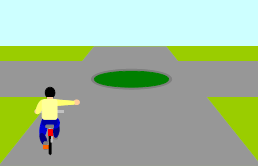 A. It is quicker route for cyclistB. The cyclist is going to turn left insteadC. The cyclist thinks The highway Code does not apply to bicyclesD. The cyclist is slower and more vulnerable
A. It is quicker route for cyclistB. The cyclist is going to turn left insteadC. The cyclist thinks The highway Code does not apply to bicyclesD. The cyclist is slower and more vulnerable
38. Motorcyclists should wear bright clothing mainly so that
A. They must do so by law
B. It helps keep them cool in summer
C. The colours are popular
D. Other road users can see them more easily
39. You are waiting to come out of a side road. Why should you watch carefully for motorcycles?
A. Motorcycles are usually faster than cars
B. Police patrols often use motorcycles
C. Motorcycles are small and hard to see
D. Motorcycles have right of way
40. What does the sign mean?
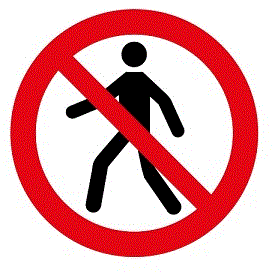 A. Pedestrian crossingB. Pedestrians in the road aheadC. No pedestriansD. Route for pedestrians
A. Pedestrian crossingB. Pedestrians in the road aheadC. No pedestriansD. Route for pedestrians
41. if you are driving behind a cyclist and you wish to turn left just ahead. You should:
A. Overtake the cyclist before the junction
B. Pull alongside the cyclist and stay level until after the junction
C. Hold back until the cyclist has passed the junction
D. Go around the cyclist on the junction
42. Where should you take particular care to look out for motorcyclists and cyclists?
A. On dual carriageways
B. At junctions
C. At zebra crossings
D. On one-way streets
43. You are dazzled at night by the lights of the vehicle behind you. You should:
A. Set your mirror to anti-dazzle
B. Set your mirror to dazzle the other driver
C. Brake sharply to a stop
D. Switch your rear lights on and off
44. What should a driver do at a pelican crossing when the red and amber lights are on?
A. Signal the pedestrian to cross
B. Always wait for the green light before proceeding
C. Give way to any pedestrians on the crossing
D. Wait for the red-and-amber light to be off before proceeding
45. If a friend wants to teach you to drive a car, they must:
A. Be over 23 and have held a full licence for at least 5 years
B. Be over 18 and hold an advanced driver’s certificate
C. Be over 18 and have fully comprehensive insurance
D. Be over 21 and have had a full license for at least three years.
46. You are coming up to a roundabout and a cyclist is signaling to turn right. What should you do
A. Overtake on the right
B. Give a horn warning
C. Signal the cyclist to move across
D. Give the cyclist plenty of room
47. You want to reverse into a side road. You are not sure that the area behind your car is clear. What should you do?
A. Look through the rear window only
B. Get out and check
C. Check the mirrors only
D. Carry on, assuming it is clear
48. You want to turn right from a main road into a side road. Just before you turn you should
A. Cancel your right-turn signal
B. Select first gear
C. Check for traffic overtaking on your right
D. Stop and set the handbrake
49. You should never attempt to overtake cyclists
A. When approaching a roundabout
B. On narrow road
C. Just before you turn left
D. On a right hand bend
50. Look at this picture. What is the danger you should be most aware of?
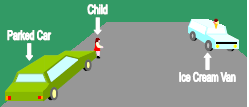 A. The ice cream van may move offB. The driver of the ice cream van may get outC. The car on the left may move offD. The child may run out into the road
A. The ice cream van may move offB. The driver of the ice cream van may get outC. The car on the left may move offD. The child may run out into the road
51. You want to turn from a junction but your view is partly restricted by parked vehicles. What should you do?
A. Move out quickly, but be prepared to stop
B. Sound your horn and pull out if there is no reply
C. Stop, then move slowly forward until you have a clear view
D. Stop, get out and look along the main road to check
52. You are driving and ahead of you there is a vehicle with a flashing amber beacon. This means it is:
A. Slow moving
B. Broken down
C. A doctor’s car
D. A school crossing patrol
53. You are driving in slow-moving queues of traffic. Just before changing lane you should:
A. Sound the horn
B. Look for motorcyclists filtering through the traffic
C. Give a ‘slowing down’ arm signal
D. Change down to first gear
54. An injured motorcyclist is lying unconscious in the road. What should you do?
A. Remove the safety helmet
B. Move them to the pavement
C. Seek medical assistance
55. You are following a motorcyclist on an uneven and bumpy road. You should:
A. Expect them to wait for you to pass
B. Speed up to get past them quickly
C. Stop and wave them across the road
D. Be careful, they may misjudge your speed
If you wish to check whether you have master these questions, you may
click on the above button to practice with questions only from this DMV topic.
If you do not have an account yet,
Sign Up one now, it is FREE!




